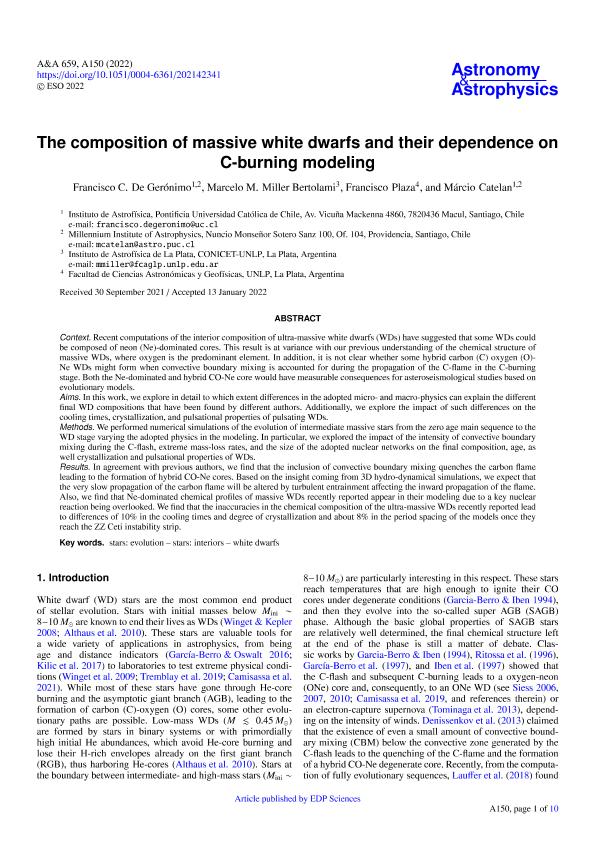Mostrar el registro sencillo del ítem
dc.contributor.author
de Gerónimo, Francisco César

dc.contributor.author
Miller Bertolami, Marcelo Miguel

dc.contributor.author
Plaza, Francisco Ezequiel

dc.contributor.author
Catelan, Márcio
dc.date.available
2023-09-15T18:06:42Z
dc.date.issued
2022-03
dc.identifier.citation
de Gerónimo, Francisco César; Miller Bertolami, Marcelo Miguel; Plaza, Francisco Ezequiel; Catelan, Márcio; The composition of massive white dwarfs and their dependence on C-burning modeling; EDP Sciences; Astronomy and Astrophysics; 659; A150; 3-2022; 1-10
dc.identifier.issn
0004-6361
dc.identifier.uri
http://hdl.handle.net/11336/211715
dc.description.abstract
Context. Recent computations of the interior composition of ultra-massive white dwarfs (WDs) have suggested that some WDs could be composed of neon (Ne)-dominated cores. This result is at variance with our previous understanding of the chemical structure of massive WDs, where oxygen is the predominant element. In addition, it is not clear whether some hybrid carbon (C) oxygen (O)-Ne WDs might form when convective boundary mixing is accounted for during the propagation of the C-flame in the C-burning stage. Both the Ne-dominated and hybrid CO-Ne core would have measurable consequences for asteroseismological studies based on evolutionary models. Aims. In this work, we explore in detail to which extent differences in the adopted micro-and macro-physics can explain the different final WD compositions that have been found by different authors. Additionally, we explore the impact of such differences on the cooling times, crystallization, and pulsational properties of pulsating WDs. Methods. We performed numerical simulations of the evolution of intermediate massive stars from the zero age main sequence to the WD stage varying the adopted physics in the modeling. In particular, we explored the impact of the intensity of convective boundary mixing during the C-flash, extreme mass-loss rates, and the size of the adopted nuclear networks on the final composition, age, as well crystallization and pulsational properties of WDs. Results. In agreement with previous authors, we find that the inclusion of convective boundary mixing quenches the carbon flame leading to the formation of hybrid CO-Ne cores. Based on the insight coming from 3D hydro-dynamical simulations, we expect that the very slow propagation of the carbon flame will be altered by turbulent entrainment affecting the inward propagation of the flame. Also, we find that Ne-dominated chemical profiles of massive WDs recently reported appear in their modeling due to a key nuclear reaction being overlooked. We find that the inaccuracies in the chemical composition of the ultra-massive WDs recently reported lead to differences of 10% in the cooling times and degree of crystallization and about 8% in the period spacing of the models once they reach the ZZ Ceti instability strip.
dc.format
application/pdf
dc.language.iso
eng
dc.publisher
EDP Sciences

dc.rights
info:eu-repo/semantics/openAccess
dc.rights.uri
https://creativecommons.org/licenses/by-nc-sa/2.5/ar/
dc.subject
STARS: EVOLUTION
dc.subject
STARS: INTERIORS
dc.subject
WHITE DWARFS
dc.subject.classification
Astronomía

dc.subject.classification
Ciencias Físicas

dc.subject.classification
CIENCIAS NATURALES Y EXACTAS

dc.title
The composition of massive white dwarfs and their dependence on C-burning modeling
dc.type
info:eu-repo/semantics/article
dc.type
info:ar-repo/semantics/artículo
dc.type
info:eu-repo/semantics/publishedVersion
dc.date.updated
2023-09-14T17:22:22Z
dc.journal.volume
659
dc.journal.number
A150
dc.journal.pagination
1-10
dc.journal.pais
Francia

dc.description.fil
Fil: de Gerónimo, Francisco César. Pontificia Universidad Católica de Chile; Chile. Instituto Milenio de Astrofísica; Chile. Consejo Nacional de Investigaciones Científicas y Técnicas; Argentina
dc.description.fil
Fil: Miller Bertolami, Marcelo Miguel. Consejo Nacional de Investigaciones Científicas y Técnicas. Centro Científico Tecnológico Conicet - La Plata. Instituto de Astrofísica La Plata. Universidad Nacional de La Plata. Facultad de Ciencias Astronómicas y Geofísicas. Instituto de Astrofísica La Plata; Argentina
dc.description.fil
Fil: Plaza, Francisco Ezequiel. Consejo Nacional de Investigaciones Científicas y Técnicas. Centro Científico Tecnológico Conicet - La Plata. Instituto de Astrofísica La Plata. Universidad Nacional de La Plata. Facultad de Ciencias Astronómicas y Geofísicas. Instituto de Astrofísica La Plata; Argentina
dc.description.fil
Fil: Catelan, Márcio. Pontificia Universidad Católica de Chile; Chile. Instituto Milenio de Astrofísica; Chile
dc.journal.title
Astronomy and Astrophysics

dc.relation.alternativeid
info:eu-repo/semantics/altIdentifier/doi/http://dx.doi.org/10.1051/0004-6361/202142341
dc.relation.alternativeid
info:eu-repo/semantics/altIdentifier/url/https://www.aanda.org/articles/aa/full_html/2022/03/aa42341-21/aa42341-21.html
Archivos asociados
